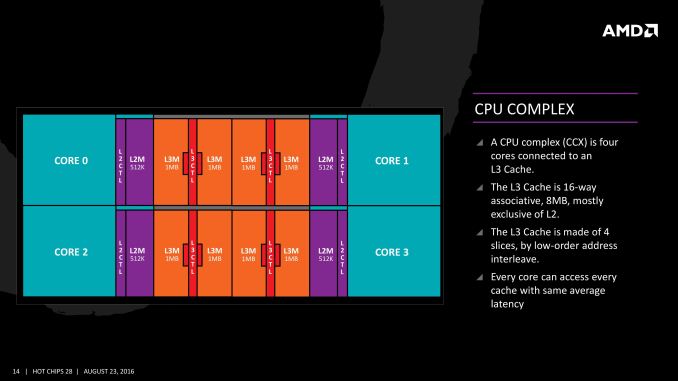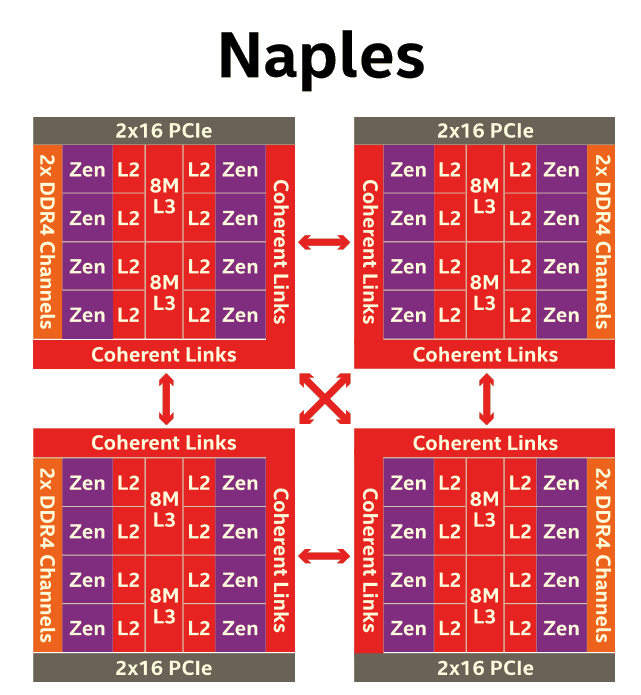Sizing Up Servers: Intel's Skylake-SP Xeon versus AMD's EPYC 7000 - The Server CPU Battle of the Decade?
by Johan De Gelas & Ian Cutress on July 11, 2017 12:15 PM EST- Posted in
- CPUs
- AMD
- Intel
- Xeon
- Enterprise
- Skylake
- Zen
- Naples
- Skylake-SP
- EPYC
AMD's EPYC Server CPU
If you have read Ian's articles about Zen and EPYC in detail, you can skip this page. For those of you who need a refresher, let us quickly review what AMD is offering.
The basic building block of EPYC and Ryzen is the CPU Complex (CCX), which consists of 4 vastly improved "Zen" cores, connected to an L3-cache. In a full configuration each core technically has its own 2 MB of L3, but access to the other 6 MB is rather speedy. Within a CCX we measured 13 ns to access the first 2 MB, and 15 to 19 ns for the rest of the 8 MB L3-cache, a difference that's hardly noticeable in the grand scheme of things. The L3-cache acts as a mostly exclusive victim cache.
Two CCXes make up one Zeppelin die. A custom fabric – AMD's Infinity Fabric – ties together two CCXes, the two 8 MB L3-caches, 2 DDR4-channels, and the integrated PCIe lanes. That topology is not without some drawbacks though: it means that there are two separate 8 MB L3 caches instead of one single 16 MB LLC. This has all kinds of consequences. For example the prefetchers of each core make sure that data of the L3 is brought into the L1 when it is needed. Meanwhile each CCX has its own separate (not inside the L3, so no capacity hit) and dedicated SRAM snoop directory (keeping track of 7 possible states). In other words, the local L3-cache communicates very quickly with everything inside the same CCX, but every data exchange between two CCXes comes with a tangible latency penalty.
Moving further up the chain, the complete EPYC chip is a Multi Chip Module(MCM) containing 4 Zeppelin dies.
AMD made sure that each die is only one hop apart from the other, ensuring that the off-die latency is as low as reasonably possible.
Meanwhile scaling things up to their logical conclusion, we have 2P configurations. A dual socket EPYC setup is in fact a "virtual octal socket" NUMA system.
AMD gave this "virtual octal socket" topology ample bandwidth to communicate. The two physical sockets are connected by four bidirectional interconnects, each consisting of 16 PCIe lanes. Each of these interconnect links operates at +/- 38 GB/s (or 19 GB/s in each direction).
So basically, AMD's topology is ideal for applications with many independently working threads such as small VMs, HPC applications, and so on. It is less suited for applications that require a lot of data synchronization such as transactional databases. In the latter case, the extra latency of exchanging data between dies and even CCX is going to have an impact relative to a traditional monolithic design.













219 Comments
View All Comments
twtech - Thursday, July 20, 2017 - link
I'd really like to see some compile-time benchmarks for these CPUs.For my own particular interests, time taken to do a full recompile of the Unreal 4 engine from source would be very useful. But even something more generic like the Linux kernel compiles per hour benchmark could serve as a useful point of reference.
szupek - Friday, July 21, 2017 - link
Meanwhile, the entire world still runs on IBM's DB2 for Datbases and IBM's Z/AS400 Mainframes. The fastest database in the world, by far...oh and the most secure (it's only hackable by standing in front of the console, seriously). Every single credit card transaction. Every single plain ticket. Most medical records and all of wall street. Yup. IBM still owns. So much that most of commenters probably have no idea just how big IBM truly is. If you care about Database speed & security, these processors shouldn't appeal to you.stevefan1999 - Saturday, July 22, 2017 - link
It's impossible for AMD to win completely.Remember kids, public cloud service providers such as Amazon(AWS), Google(GCP) and Joyent would still stick with Intel due to not only the compatibility issues like ecosystem and vendor inconsistency, but also the VM migration and security and module issues, all mentioned in the presentation slides presented by Intel. They are a very serious matter, as they, the public cloud services, are powering the Internet we use everyday, so being stable, consistent and be able to serve a good amount of SLA is vital to the public cloud, we wouldn't expect them to play with the new lad in the hood, the EPYC.
IIRC only the Microsoft(Azure) are using AMD server CPUs partially in some of their datacenters, running various Linux and Windows VMs using Hyper-V, and they have been performing quite well
The cloud services are exploding every year, but with what I've said, I doubt AMD could even kick in the first door at least for 3 to 4 years. This is still a big-win for Intel and what manipulations will Intel do I don't know.
On the other hand, Intel has failed to service the desktop market and they're figuring out how to hold their asses on the Internet infrastructure, never had them know the crusade of EPYC will come this fast.
The server market is quite a big meat, it's a 21 bil market, cool right? But that you will have guaranteed 'server upgrade' every year, is a bigger matter, as those server CPUs are designated to be disposed given the wattage and performance per dollar is lower on the newer CPUs. Those god-damn server operators will keen to replace their CPU (and therefore some serious metal pollution issues). Intel has been exploiting this and gained a big hurdle of money and therefore had their ecosystem grown. This is how Intel defends their platform by vendor lock-in, pathetic.
AMD is now being performance and cost competitive to Intel, but it's still dead in the High Performance Computing campaign unless AMD could provide higher frequencies. Well I have to say I know nothing about HPC, but I remembered the Bulldozer architecture of AMD is actually targeted and marketed for HPC! That's why AMD failed in general-purpose computing market and started the downfall of AMD/Domination of Intel 5 years ago. Even though we know the fate of Bulldozer, but hopefully AMD could still scrap some of the HPC goodies of Bulldozer out and benefits the mankind by accelerating researches such as finding the cures for cancer or solving some precise physics and mathematics.
Well, anyway the cloud, the HPC and the server market are the last resort for Intel and they will definitely hold their last ground. Good luck AMD on crushing the mean and obese Intel!
errorr - Sunday, July 23, 2017 - link
For all the talk about speed and efficiency the problem is about $$$. The sad fact is that what matters most isn't even the price of the cpus which is chump change in the grand scheme of things but how the software licensing costs are determined. Per core or per socket software pricing will matter a lot. The software companies will decide how successful EPYC is. I have a feeling they will be biased slightly toward AMD at the beginning as it is in their interest to foster competition for Intel, or if they are not forward looking enough the end customers might argue that the competition will benefit the SW companies in the long run by continuing to push competition.msroadkill612 - Thursday, July 27, 2017 - link
Whatever, its all pointless if the competition can read your secrets, which is a matter very close to the hearts of the cheque signers.AMD seem to have something very superior to offer in that department.
qweqwe - Tuesday, August 8, 2017 - link
we just did some heavy inhouse hpc-tests with epyc against diff. intel servers.the epyc is the clear winner in terms of performance and power consumption when it
comes to hand-tuned parallel-vector-code examples.
not bad amd !
readonly1 - Friday, October 27, 2017 - link
qweqwe, I totally agree with you. Our inhouse HPC tests get the similar conclusion, after comparing AMD Epyc 7351 (dual socket, 32 cores, 2400Mhz) and Intel SKylake 6154 (dual socket, 36 cores, 3000Mhz). I think AMD clearly wins in the memory bandwidth, which is extremely important for HPC computation.msroadkill612 - Monday, November 13, 2017 - link
7/11/2017 "Microsoft is already deploying AMD's EPYC in their Azure Cloud Datacenters."Interesting. As i have been theorising, a possible reason for the absence of retail epyc is not supply, but demand.
A single sale can soak up production runs.
If so tho, not much sign of big revenues from it yet, but there are other explanations for that. Contra processors for development work e.g.
q.epsilon.p - Sunday, June 10, 2018 - link
power consumption numbers with every benchmark would have been nice, because these parts are server benchmarks, Perf / Watt is one of the primary concerns. And where AMD kinda crush Intel, because it's isn't exactly being honest with it's TDP values nowadays when it comes to Data Centre and HEDT.TDP was traditionally the absolute maximum the CPU would put out as heat, now with a power consumption of 670W I am assuming that the heat being put out by the CPU is more than 165W.